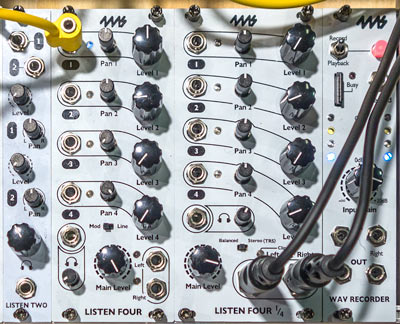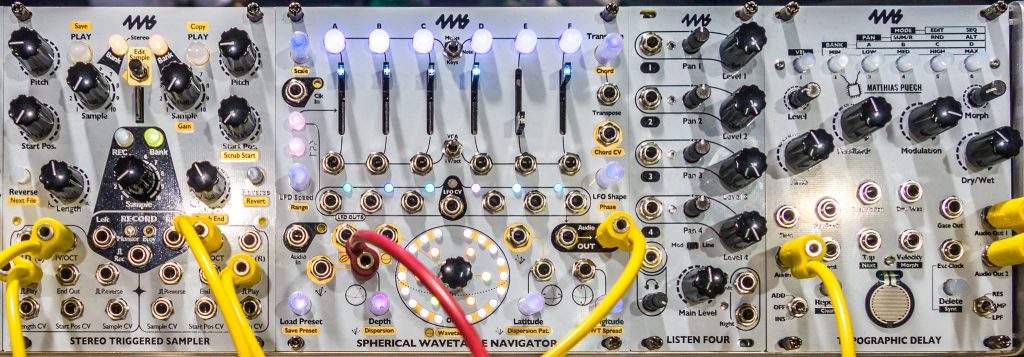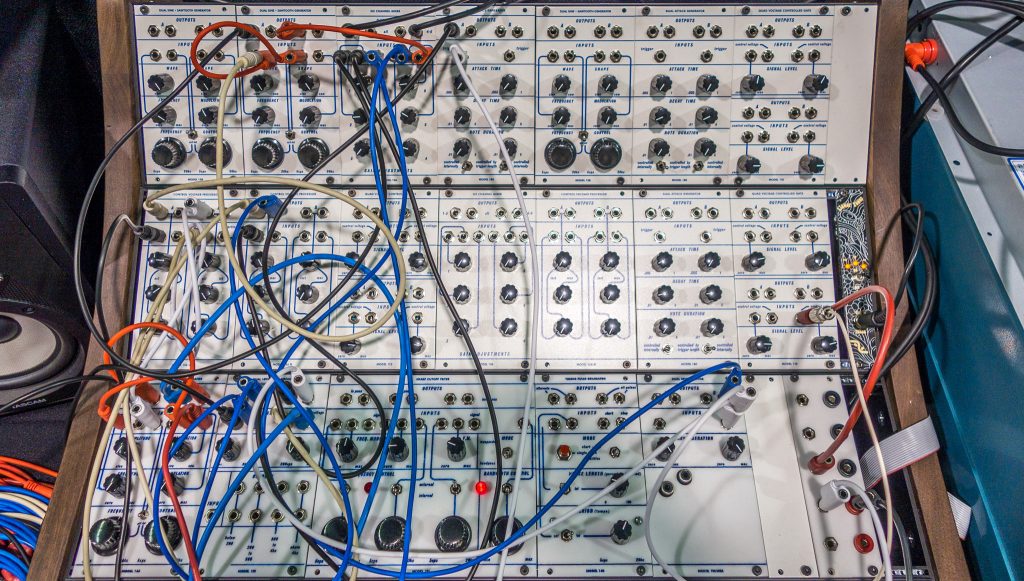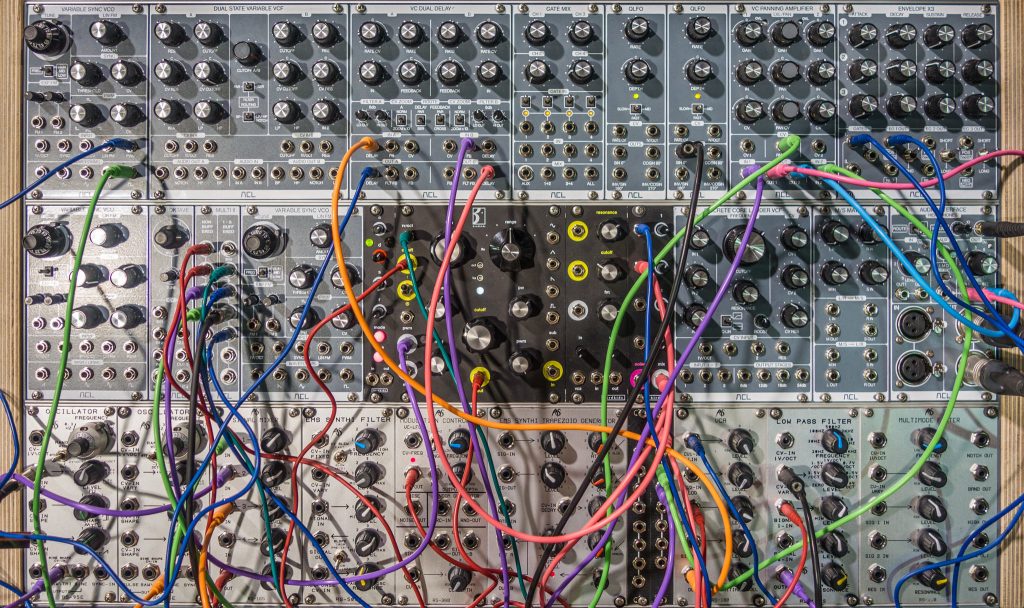For the last couple of years I’ve written up my conversations with all of the modular manufacturers I could visit during the most recent NAMM show, starting on the first night of the show. This year I was on a different schedule, as I planned a short vacation after NAMM, followed by surgery. So I posted first impressions during the show to my Patreon supporters, and wrote up a NAMM report based on different themes for the February 2018 Learning Modular email newsletter. Now that I am started the road to recovery after that surgery (today’s report is brought to you, by the way, by Oxycodone), I’m starting my manufacturer-by-manufacturer reports, to be spread out over several installments.
For those who have not visited NAMM recently, the modular area is dominated by three large booths with a variety of manufacturers in each one: WMD’s (primarily for the American manufacturers), Alex4 (the main overseas distributor for many European manufacturers), and Malekko (who show off their own goodies as well as those by Erica Synths and others). Other manufacturers like Intellijel, Pittsburgh, Moon Modular, and Foxtone (which owns several brands, now including Buchla) were nearby, with only a few other manufacturers scattered some distance away from there (Buchla in their own booth, with newly-appointed company historian Marc Doty holding court; Waldorf was in the Korg booth as that’s there new US distributor; Strymon was downstairs in the acoustic area). Several manufacturers – including Moog and Make Noise – decided not to attend this year.
4ms
One of the modules that was getting a lot of attention at the show was the 4ms Spherical Wavetable Navigator (~$475), the brainchild of Hugo Paris. This very deep module was given a preview at Superbooth last year; it has been updated considerably since then, both inside and out. It contains six wavetable VCOs as well as six LFOs. Each VCO accesses and morphs between waves arranged into a three-dimensional sphere. You can navigate around inside this sphere to change the sound. Each VCO can be tuned independently; indeed, you can use the “SWR” as a six-VCO polyphonic voice (there are hard-assigned left or right outputs available, as well as a mono mix), or tune the individual oscillators to form chords or create detuning. Each VCO is sent to its own VCA with a front panel slider and optional CV input. You can also assign the six internal LFOs – which can be independent, or synchronized to form patterns – to control those six VCAs. There are a variety of LFO shapes available, including gates and triggers to sound single notes from the individual VCOs. The results varied from arpeggiations to abstract washes of timbre.
You might have noticed in the image above that there are some parameter names inside gold ovals. When you turn the encoder above normal black text on white (the encoder shafts also have multicolored LEDs now as well), you are editing that value; when you press the encoder shaft and rotate at the same time, you are editing the parameter in gold. Most of the controls are also either global (all six edited at once) or targeted to the channels you’ve selected with the pushbuttons above the faders. Dan Green also noted that a little bit of randomization in parameter values goes a long way to creating motion in the sound, instead of it settling on a static buzz.
It’s an amazing-sounding module, and they are still adding features (such as deciding exactly what the Audio In will do, and how users can create their own wavetables). My only concern is how easy it will be for the user to explicitly plot out the tonal evolution of a sound. I obviously have a bias toward the Vector Synthesis approach where the user gets to pick their own waveforms for the corners of their world as well as how to navigate through it. Indeed, when I first met this module I assumed the six oscillators would be assigned to the north, south, east, west, above, and below directions inside a sphere, and the Depth, Latitude, and Longitude controls would then be used to fly and morph between these waves. I was wrong: Again, each oscillator already has its own 3D array of waveshapes, and these six spheres are overlaid into the same space.

Catalyst Audio
I spoke with David Small of Catalyst Audio at NAMM last year as he floated the idea of building recreations of the Buchla 100 series modules as faithfully as possible in the Eurorack format, using the original through-hole components and the such. He took the feedback from many last year to heart, tweaked the designs to make them more Eurorack friendly (1v/octave tracking, plus a jumper on the back to choose between the traditional Buchla +/-1 audio levels and more Eurorack-friendly +/-4v audio levels), and released a set of six modules:
- Model 106 6-Channel Mixer ($249)
- Model 110 Quad Gate (four VCAs – Buchla wasn’t making LPGs at this point – with an unusual “S” curve to their response which adds compression at the high end; $299)
- two versions of the Model 156 Control Voltage Processor Mixer (a vintage version for $249 that works like the original, as well as a modern version for $179 that can handle bipolar voltages and also has up to a 1.5x signal boost)
- Model 158 Dual Sine-Sawtooth Generator (which has linear FM, as opposed to the exponential I reported last year; $449)
- Model 180 Dual Attack Generator (linear slopes; $299)
After selling out the first production run, he built more, and also brought prototypes of five more modules to NAMM (from left to right in the bottom row in the picture above):
- Model 144 Dual Square Wave Generator (supporting both AM and FM)
- Model 194 Dual Bandpass Filter (with 4 fixed frequencies), combined with a dual lowpass filter
- Model 191 Sharp Cutoff Filter four-pole low & high pass filter
- Model 140 Timing Pulse Generator
- Model 190 Dual Reverberator spring reverb (where he admits he had to replace the original now-$200-each transformers with more modern and cost effective – but still sonically faithful – versions)
All of these modules use discrete transistor designs, often resulting in non-linearities in response as well as that gentle saturation I enthused about in my recent Verbos module videos about his transistor input stages. Numerous users noted how “organic” the Catalyst Buchla recreations sound; the VCOs in particular sounded particularly nice with FM, despite tracking accuracy not being up to modern digital standards (David says you can safely get 2 octaves, and maybe 3 – which, to be honest, covers most bass lines, arpeggios, etc.).
ACL (Audiophile Circuits League)
The Berlin-based company formerly known as AQA ElectriX sent a case of their re-paneled modules, including a few new ones that they mentioned last year. One of these was their Discrete Core Ladder VCF http://audiophilecircuitsleague.com/products/discrete-core-ladder-vcf.php (~ €412 + VAT). Each filter pole – 6bB, 12dB, 18dB and 24dB – has its own output, meaning it becomes a quadrature-phase sine wave VCO when self-oscillating. The resonance has variable output level compensation (called Boost) so you can compensate for the normal drop off in bass when you increase the resonance with a transistor ladder filter. As is the case with most ACL modules, it is very clean by design, but is eager to be overdriven with saturation kicking in by +/-4v (most oscillators output at least +/-5v…and that’s before mixing multiple waveforms together!).
There are also three new modules, including:
- Gate Mix (a four-channel mixer with switches and gate inputs to mute individual channels – €240 + VAT)
- a high-quality Audio Interface with two channels of balanced XLR input and output, as well as a stereo 3.5mm jack that can be mixed with either one as well as a switchable headphone monitor (~€387 + VAT
- Oktave – a nice precision adder with three inputs that are added together, a switch for a +/-4 octave offset, a fine tune control to adjust the final mix up or down by nearly a fifth (7 semitones), four buffered outputs to feed your VCOs, and an inverted output (~€142 + VAT).
ACL also introduced a new case & power supply system, including an unusual hexagonal Power Distribution Board to shorten the ground runs and therefore resistance, reducing noise in a system.
Analogue Systems & birdkids
You might notice some birdkids and Analogue Systems modules residing in the ACL case above (as well as the Analogue Systems case at the top of this post). Analogue Systems – the second company to make “Eurorack format” modules, after Doepfer (albeit with different mounting hole spacing and power connectors) – is still in business and making modules, specializing in recreations of EMS synth sections as well as their own designs. SchneidersLaden in Berlin sell them; I bought an RS-420 Octave Controller from them awhile back. Even more crucial, SchneidersLaden also sells the all-important AS to Eurorack power cable adaptor.
I spoke with Michael Beim of birdkids at length at NAMM next year, and he had some very interesting module plans, but since the release of the compact, all-in-one Bateleur System, I’ve been told by other that their interest lies more in that direction these days.





Have you got Analogue Systems & Analogue Solutions mixed up? (I am blaming the Oxycodin)
Yep – I do. (Kids: Learn from Uncle Chris; don’t do drugs. Or at least, don’t try to act smart while doing drugs.) Fixed in the article now.
Although the truth behind the mistake is far more convoluted. My mind says “Analogue…more gravitas than Analog…which sounds like it has more gravitas? It must be Solutions, not the lighter-sounding Systems.”
Thanks for the catch!